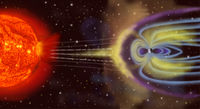
Photo from wikipedia
Background: Magnetic resonance imaging (MRI)-guided radiotherapy is a promising image-guided cancer radiotherapy method. For MRI-guided radiotherapy, the proper energy of a therapeutic beam is important for beam-designing processes, and the… Click to show full abstract
Background: Magnetic resonance imaging (MRI)-guided radiotherapy is a promising image-guided cancer radiotherapy method. For MRI-guided radiotherapy, the proper energy of a therapeutic beam is important for beam-designing processes, and the magnetic-induced dose perturbation would be mainly influenced, especially the perturbation surrounding the tissue–air or air–tissue interfaces. Thus, it was necessary to investigate the impact of beam energy from photon, proton, and carbon ion beams on the magnetic-induced dose perturbations. Materials and Methods: Using a phantom of a water-air-water structure, the dose distributions were calculated with or without the presence of a 1.5 T uniform magnetic field through GEANT4. Based on the calculated doses, magnetic-induced dose perturbations were then obtained. For investigating the effects of beam energies on magnetic-induced dose perturbations, low-, middle-, and high-beam energies were adopted for each beam type. Results and Discussion: For photon beams, the dose perturbations were increased as the beam energies increased. At the up water–air interface, the maximum perturbations exceeded 50%. Near the edge of the radiation field, perturbations of 5%–20% were achieved. For proton and carbon ion beams, their Bragg peaks were shifted from original positions, and the shifting distances were increased with the increased beam energies. However, no evident magnetic-induced dose perturbations were noted at the up water–air interface and bottom air–water interface for all the beam energies. To some extent, this study provided references for assessing the effects of beam energies on magnetic-induced dose perturbations, especially the perturbations around the air cavities inside cancer patients. Conclusion: In MRI-guided cancer radiotherapy, the dose perturbation effects for therapeutic beams are relatively obvious, and the beam energies of therapeutic beams have large impacts on the magnetic-induced dose perturbations with the presence of a 1.5 T transverse magnetic field.
Journal Title: Journal of Cancer Research and Therapeutics
Year Published: 2018
Link to full text (if available)
Share on Social Media: Sign Up to like & get
recommendations!